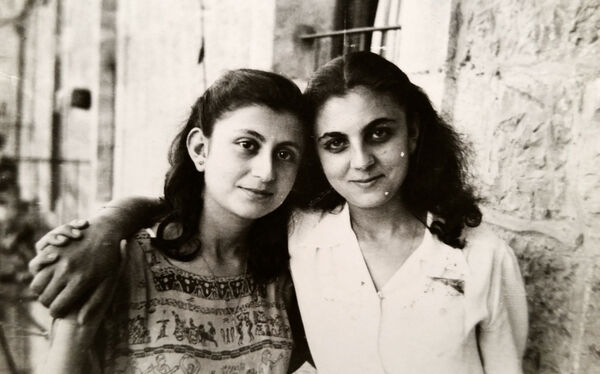Newsletter
May
15
2023

Jewish Currents board member Nadia Saah’s mother, Nina (left), and her mother’s cousin, Leila (right), at home in Jerusalem in 1947.
Courtesy of Nadia Saah
THIS PHOTOGRAPH IS OF MY MOTHER NINA, on the left. Her given name was Therese Yousef Saad, but her family called her Theresina because she was tiny and adorable—and she remained that way until her death in 2017. She is standing next to her cousin Leila on the balcony of her family’s home in Jerusalem. It is 1947, and she is engaged to my father Issa. (They would not marry until 1963. But that’s another story.) The photo conveys a deep intimacy: my mother’s easy grip on Leila’s hand; their closeness; the depth and warmth of my mom’s almond eyes. She is looking right at you, and at me. She is letting us in.
One year later, the Nakba ended her life in Palestine. I know that my mom and her family fled on a truck to As-Salt, Jordan, in May of 1948, and for a year and a half the six of them—she and her mother Lily, her father Yousef, her sisters Diana and Irma, and her baby brother Mattia—lived together in one room, over a barn. I know that on their first night they cried as they ate their dinner on the floor. And that the walls shook every time a horse kicked below them. I know that my mother prayed for their return to Jerusalem, until the day that she climbed the tallest hill in As-Salt to witness the waves of Palestinian refugees walking toward her with their belongings on their backs.
I will never know the full extent of what happened to my mother in the Nakba, but I can tell you that during the 47 years that I knew her, I never once saw this look in her eyes. The photo captures a time before the trauma of the Nakba, when Zionist militias drove more than 750,000 Palestinians out of their homes and off their land in order to establish the State of Israel as a Jewish-majority country. For me and many other Palestinians, images like this one are gold. Zionist devastation of our lives and suppression of our histories renders our photographs proof of life, crucial evidence of our existence in all its rich complexity and beauty. Such images are passed down along with our family stories as a vital record of a world that was taken from us, abruptly ended—a collective death. (Palestinians die many times before dying.) When I founded Project48, an initiative to tell the story of the Nakba by centering Palestinian voices, I knew that our precious photos would play a profound role in telling our stories. These images cut to the quick, making clear exactly what we mean by the Nakba, our catastrophe.
To mark the 75th anniversary of the Nakba, Jewish Currents—in partnership with Project48 and the Institute for Middle East Understanding—invited Palestinians to submit photographs that speak to their family’s experience of the Nakba, along with brief reflections on the images. We received many kinds of images, historical and contemporary. Some, like the photo of my mother and her cousin, offer a glimpse of life in Palestine before the first mass expulsion in 1948; others depict beloved objects carried into exile or stolen homes visited by descendents who cannot return to reclaim them; still others speak to the continued process of dispossession, 75 years on. As this archive makes clear, the Nakba is not a discrete event, but an ongoing process of dispossession whose meanings cannot be captured by any single narrative. By asserting our Palestinian histories, we are manifesting a future rooted in justice, charting the way for our return.
- Nadia Saah, 52, Brooklyn, New York